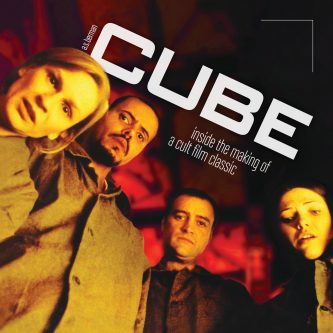 By A.S. BERMAN (BearManor Media; 2018)
By A.S. BERMAN (BearManor Media; 2018)
An excellent idea for a book if you ask me: a behind-the-scenes look at Vincenzo Natali’s 1997 science fiction-horror classic CUBE, one of the most interesting low-budgeters to emerge from the nineties, and certainly one of the decade’s premiere Canadian films. Author A.S. Berman, it can safely be stated, goes above and beyond the call of duty, providing an attractively designed book that contains extensive commentary by most of the principal technicians and actors involved in the film’s creation (in particular Natali himself), and is profusely illustrated with stills, behind the scenes photos, sketches and storyboards.
Also included is a mini-biography of Natali, a precocious Toronto native who like many an independent filmmaker grew up making short films. Along for the ride were CUBE’S co-scripter Andre Bijelic, who lived near Natali in his early years, and the film’s co-star David Hewlett, who went on to appear in quite a few of Natali’s later efforts.
Natali’s employment as a storyboard artist for the Canuck Cartoon outfit Nelvana was an essential component in the creation of CUBE, which was widely noted for its meticulous visual design. During CUBE’S chaotic month-long shoot Natali was forced to contend with malfunctioning props, mutinous crewmembers, overheated sets and a constant shortage of funds, yet somehow the film was completed, and went on to become a cult classic—which occurred, as Berman makes clear, long after its 1998 North American theatrical release, which was at best a minor success.
Natali’s career in the years following CUBE is also covered in these pages. That career contained some high points, such as 2009’s SPLICE, and quite a few low ones, with Natali becoming mired in the Hollywood purgatory known as Development Hell, and ultimately finding satisfaction of a sort by directing episodic television in his native Canada. We also get the lowdown on the two early-00 CUBE sequels, which were made without Natali’s input; Berman is rightfully disdainful about CUBE 2: HYPERCUBE (2002), but finds much to admire about CUBE ZERO (2004), which he dubs a “pretty intriguing little sci fi thriller that…actually brings something new to the table.”
Of this book’s subject Berman may be a bit overly effusive. He proclaims it a “cult masterpiece” that “belongs to another age yet somehow remains timeless,” and even finds in it a “metaphor for the great oppressive forces, large and small, that rule our lives.” Yet it’s an inescapable fact that CUBE is indeed a damn good film, and one’s appreciation for it only increases after learning of the not-inconsiderable challenges faced by its makers that are unveiled in this book.
